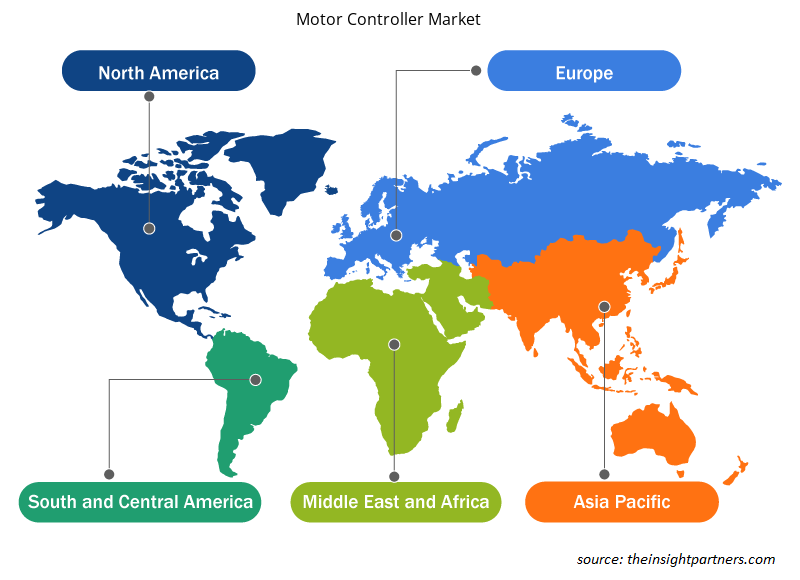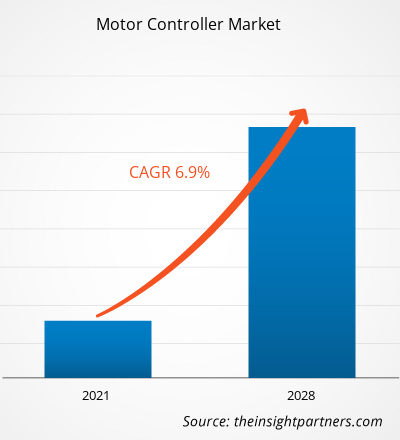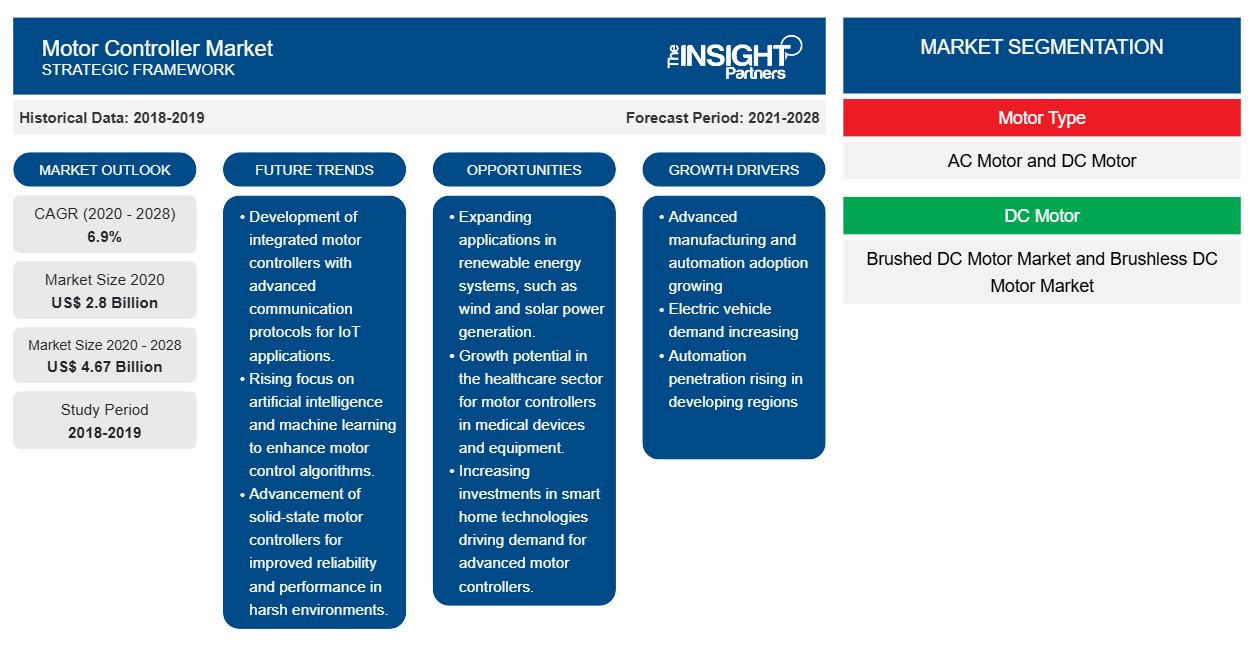Nel 2020, il mercato dei controller per motori era valutato 2.800,7 milioni di dollari USA e si prevede che raggiungerà i 4.674,1 milioni di dollari USA entro il 2028; si prevede una crescita a un CAGR del 6,9% dal 2021 al 2028.CAGR of 6.9% from 2021 to 2028.
Il mercato globale dei controller motore è suddiviso in cinque regioni principali: Nord America, Europa, APAC, MEA e SAM. Uno dei fattori chiave che guidano la crescita del mercato dei controller motore è la crescente adozione di processi avanzati e automatizzati nel settore manifatturiero, unita alla crescente penetrazione dell'automazione nelle regioni in via di sviluppo. Le industrie di tutto il mondo hanno sperimentato rapidi sviluppi in termini di produzione e tecnologia. In questo corso, i produttori di automobili stanno aggiornando i sistemi, aggiungendo capacità di ispezione e networking e sfruttando le tecnologie di integrazione per produrre un prodotto migliore ed economico in tempi più brevi. C'è un'elevata domanda di motori a trasmissione diretta e servomotori in elettrodomestici, applicazioni di e-mobility e veicoli a guida automatica (AGV) che dovrebbero svolgere un ruolo significativo nell'istigare la domanda di prodotti. Inoltre, si prevede che la crescente domanda di veicoli elettrici e l'implementazione di rigide normative governative sull'uso di prodotti a risparmio energetico rafforzeranno la crescita del mercato durante il periodo di previsione. Inoltre, i dispositivi di controllo motore contribuiscono a migliorare l'efficienza dei processi di produzione e degli impianti di produzione nel settore automobilistico, mentre i paesi in via di sviluppo come India, Cina, Brasile e Taiwan stanno adottando sistemi di controllo motore avanzati nelle loro industrie manifatturiere per realizzare prodotti a risparmio energetico.
Impatto della pandemia di COVID-19 sul mercato dei controller motore
La pandemia di COVID-19 continua a limitare la crescita delle industrie manifatturiere complessive a causa dell'interruzione delle attività della catena di fornitura e della chiusura del commercio internazionale da parte di diversi paesi. Di conseguenza, vari paesi hanno assistito a un calo della domanda di prodotti di automazione come controllo degli ascensori, apparecchiature di assemblaggio/imballaggio, robotica e sistemi di controllo del volo, che ha successivamente influenzato negativamente le prestazioni del settore dei controller dei motori. Pertanto, si prevede che il mercato si riprenderà nei prossimi mesi.
Personalizza questo report in base alle tue esigenze
Riceverai la personalizzazione gratuita di qualsiasi report, comprese parti di questo report, o analisi a livello nazionale, pacchetto dati Excel, oltre a usufruire di grandi offerte e sconti per start-up e università
-
Scopri le principali tendenze di mercato in questo rapporto.Questo campione GRATUITO includerà analisi di dati che spaziano dalle tendenze di mercato alle stime e alle previsioni.
Approfondimenti sul mercato - Mercato dei controller motore
I crescenti investimenti nei veicoli a motore elettrico stanno alimentando la domanda di controller motore. Molte aziende automobilistiche sono sul punto di iniziare la produzione su larga scala di veicoli a motore elettrico. Nel 2019, la Ford Motor Co. ha annunciato il ritmo di produzione di motori elettrici presso il suo stabilimento Van Dyke Transmission nella periferia di Detroit. L'azienda sta pianificando di spendere circa 11,5 miliardi di USD in veicoli elettrici e ibridi fino al 2022; come parte di ciò, l'azienda dovrebbe consegnare 40 veicoli elettrificati, di cui 16 completamente elettrici. Tali investimenti in corso nello sviluppo e nella produzione di veicoli elettrici stanno rafforzando la domanda di dispositivi avanzati di controller motore.USD 11.5 billion on electric and hybrid vehicles through 2022; as part of this, the company is expected to deliver 40 electrified vehicles, including 16 completely electric ones. Such ongoing investments on electric vehicle development and production are bolstering the demand for advanced motor controller devices.
Informazioni sul segmento del tipo di motore
I dispositivi di controllo motore coordinano principalmente in modo predeterminato le prestazioni del motore elettrico. Un controllo motore include un mezzo manuale o automatico per avviare e arrestare il motore, selezionare la rotazione in avanti o indietro, selezionare e regolare la velocità, regolare o limitare la coppia e proteggere da sovraccarichi e guasti elettrici. In base al tipo di motore, il mercato dei controllori motore è diviso in motori CA e motori CC.
Approfondimenti sul segmento dei motori DC
Per quanto riguarda i motori DC, il segmento di mercato dei motori DC brushless ha dominato il mercato globale dei controller per motori con una quota del 70,39% nel 2020. Inoltre, si prevede che lo stesso segmento continuerà a dominare durante il periodo di previsione, arrivando a rappresentare il 70,19% della quota di mercato entro la fine del 2028.brushless DC motor market segment dominated the global motor controller market with 70.39% share in 2020. Also, the same segment is anticipated to continue its dominance during the forecast period to account for 70.19% of the market share by the end of 2028.
Panoramica del segmento di potenza in uscita
In base all'intervallo di potenza in uscita, il segmento 0,6-1,0 HP ha dominato il mercato globale dei controller motore con una quota del 40,94% nel 2020. Inoltre, si prevede che lo stesso segmento continuerà a dominare durante il periodo di previsione per rappresentare il 42,21% della quota di mercato entro la fine del 2028.
Informazioni sul segmento del tipo di tensione
In base al tipo di tensione, il segmento dei motori inferiori a 1 kV ha dominato il mercato globale dei controller per motori con una quota del 51,74% nel 2020. Inoltre, si prevede che lo stesso segmento continuerà a dominare durante il periodo di previsione per rappresentare il 54,57% della quota di mercato globale entro la fine del 2028.
Informazioni sul segmento di utenti finali
Per utente finale, il segmento industriale ha dominato il mercato globale dei controller motore con una quota del 38,66% nel 2020. Inoltre, si prevede che lo stesso segmento continuerà a dominare durante il periodo di previsione per rappresentare il 35,01% della quota di mercato entro la fine del 2028.
Gli operatori del mercato si concentrano sulle innovazioni e sugli sviluppi di nuovi prodotti integrando tecnologie e funzionalità avanzate nei loro prodotti per competere con i concorrenti.
Approfondimenti regionali sul mercato dei controller motore
Le tendenze regionali e i fattori che influenzano il mercato dei Motor Controller durante il periodo di previsione sono stati ampiamente spiegati dagli analisti di Insight Partners. Questa sezione discute anche i segmenti e la geografia del mercato dei Motor Controller in Nord America, Europa, Asia Pacifico, Medio Oriente e Africa e America meridionale e centrale.

- Ottieni i dati specifici regionali per il mercato dei controller motore
Ambito del rapporto di mercato del controller del motore
| Attributo del report | Dettagli |
|---|---|
| Dimensioni del mercato nel 2020 | 2,8 miliardi di dollari USA |
| Dimensioni del mercato entro il 2028 | 4,67 miliardi di dollari USA |
| CAGR globale (2020 - 2028) | 6,9% |
| Dati storici | 2018-2019 |
| Periodo di previsione | 2021-2028 |
| Segmenti coperti |
Per tipo di motore
|
| Regioni e Paesi coperti |
America del Nord
|
| Leader di mercato e profili aziendali chiave |
|
Densità dei player del mercato dei controller motore: comprendere il suo impatto sulle dinamiche aziendali
Il mercato dei Motor Controller Market sta crescendo rapidamente, spinto dalla crescente domanda degli utenti finali dovuta a fattori quali l'evoluzione delle preferenze dei consumatori, i progressi tecnologici e una maggiore consapevolezza dei vantaggi del prodotto. Con l'aumento della domanda, le aziende stanno ampliando le loro offerte, innovando per soddisfare le esigenze dei consumatori e capitalizzando sulle tendenze emergenti, il che alimenta ulteriormente la crescita del mercato.
La densità degli operatori di mercato si riferisce alla distribuzione di aziende o società che operano in un particolare mercato o settore. Indica quanti concorrenti (operatori di mercato) sono presenti in un dato spazio di mercato in relazione alle sue dimensioni o al valore di mercato totale.
Le principali aziende che operano nel mercato dei controllori motore sono:
- ABB Ltd.
- AMETEK Inc.
- Società Eaton
- Compagnia elettrica generale
- AUTOMAZIONE ANAHEIM, INC.
Disclaimer : le aziende elencate sopra non sono classificate secondo un ordine particolare.

- Ottieni una panoramica dei principali attori del mercato dei controller motore
Il mercato globale dei controller motore è stato segmentato come segue:
Mercato dei controller del motore - per tipo di motore
- Motore AC
- Motore a corrente continua
Mercato dei controller del motore - per motore CC
- Mercato dei motori DC spazzolati
- Mercato dei motori DC senza spazzole
Mercato dei controller del motore – per intervallo di potenza in uscita
- Inferiore a 0,5 CV
- 0,6–1,0 CV
- 1,0–3,0 CV
- Oltre 3,0 CV
Mercato dei controller del motore – per tipo di tensione
- Motori inferiori a 1 kV
- Motori da 1 kV a 6,6 kV
- Più di 6,6 kV
Mercato dei controller del motore – per utente finale
- Industriale
- Commerciale
- Residenziale
- Trasporti
- Agricoltura
Mercato dei controller del motore – per regione
-
America del Nord
- NOI
- Canada
- Messico
-
Europa
- Francia
- Germania
- Italia
- Regno Unito
- Russia
- Resto d'Europa
-
Asia Pacifico (APAC)
- Cina
- India
- Corea del Sud
- Giappone
- Australia
- Resto dell'APAC
-
Medio Oriente e Africa (MEA)
- Sudafrica
- Arabia Saudita
- Emirati Arabi Uniti
- Resto del MEA
-
America del Sud (SAM)
- Brasile
- Argentina
- Resto del SAM
Mercato dei controller del motore – Profili aziendali
- ABB Ltd.
- AMETEK Inc.
- Società Eaton
- Compagnia elettrica generale
- AUTOMAZIONE ANAHEIM, INC.
- SISTEMI AD ARCO INC.
- ErieTec Inc
- Microchip Technology Inc.
- Società Nidec
- Società Parker-Hannifin
- Analisi storica (2 anni), anno base, previsione (7 anni) con CAGR
- Analisi PEST e SWOT
- Valore/volume delle dimensioni del mercato - Globale, Regionale, Nazionale
- Industria e panorama competitivo
- Set di dati Excel
Report recenti
Rapporti correlati
Testimonianze
Motivo dell'acquisto
- Processo decisionale informato
- Comprensione delle dinamiche di mercato
- Analisi competitiva
- Analisi dei clienti
- Previsioni di mercato
- Mitigazione del rischio
- Pianificazione strategica
- Giustificazione degli investimenti
- Identificazione dei mercati emergenti
- Miglioramento delle strategie di marketing
- Aumento dell'efficienza operativa
- Allineamento alle tendenze normative























 Ottieni un campione gratuito per - Mercato dei controllori motori
Ottieni un campione gratuito per - Mercato dei controllori motori